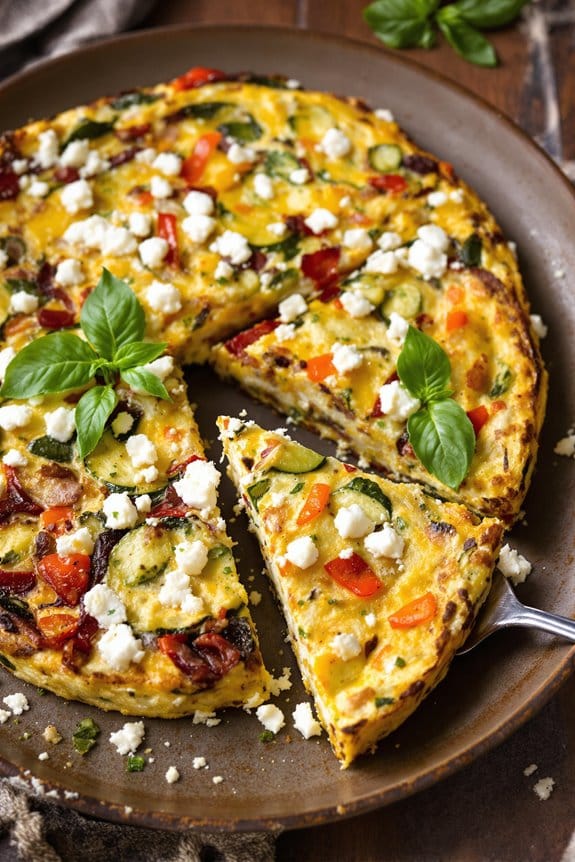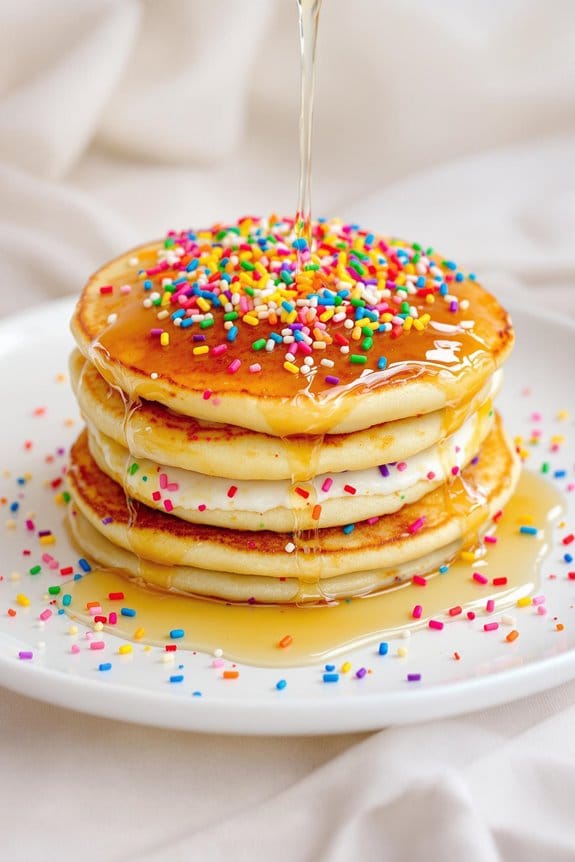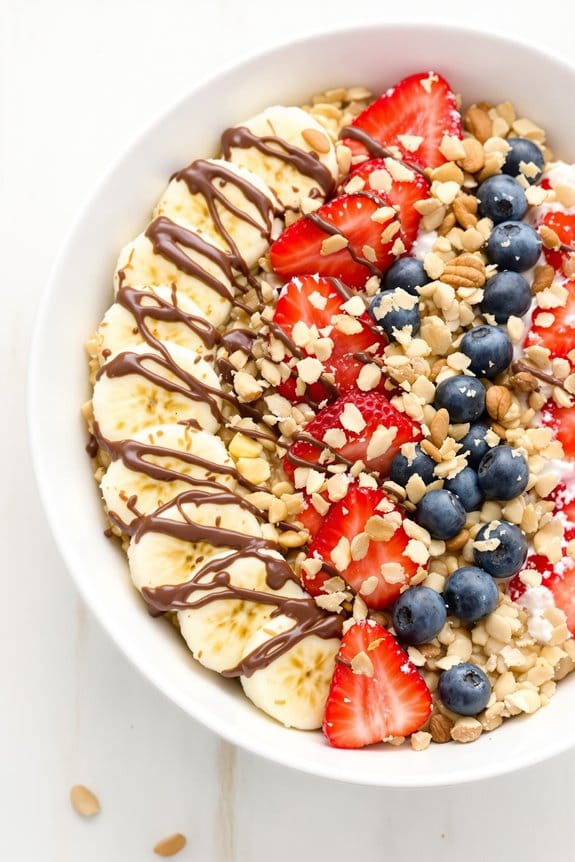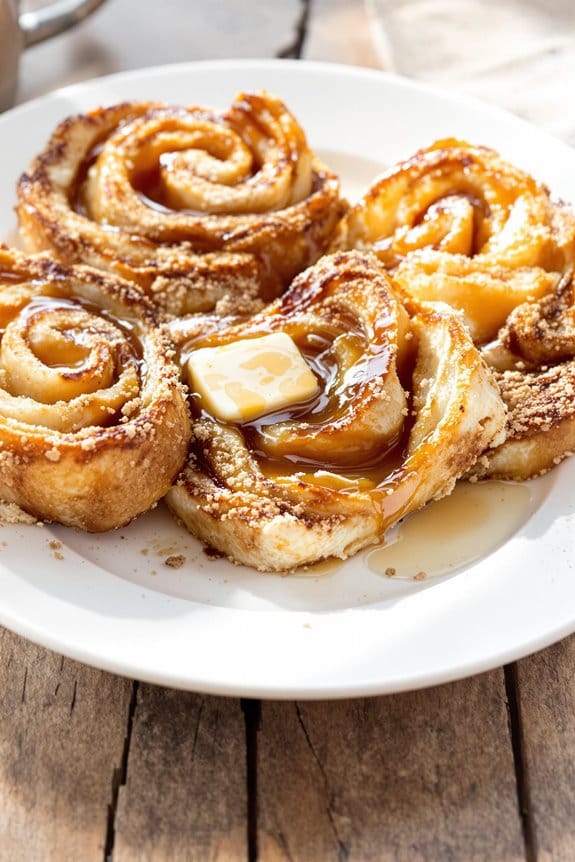Have you ever considered elevating your brunch or dinner with a Roasted Veggie & Goat Cheese Frittata? This dish not only bursts with colors and flavors from roasted red bell peppers, zucchini, and yellow squash, but the addition of tangy goat cheese complements the succulent, earthy veggies superbly. As you whisk the eggs and fold in the roasted ingredients, you’re crafting a meal that’s not just visually appealing but also packed with nutrients. Now, imagine when these ingredients blend under heat, releasing aromatic scents that promise a mouth-watering meal. What kind of atmosphere does this create for your dining experience, and how might it redefine your idea of a wholesome meal?
History
The origins of frittatas date back to Italy, where they emerged as a savvy solution to make use of leftover ingredients. This clever dish started as a humble creation, highlighting the Italian knack for turning simple items into delightful meals.
As you explore its history, you’ll discover that frittatas aren’t just a modern-day brunch staple but have deep cultural roots that reflect an economical approach to cooking. It’s a tradition born from necessity, emphasizing resourcefulness in the kitchen.
Over time, the frittata has evolved, transforming from a simple peasant meal to a canvas for culinary artistry. Italian cooks have long embraced the frittata’s versatility, whipping up versions that incorporate whatever is on hand—cheeses, vegetables, meats, and herbs.
This adaptability made the dish popular among busy households and has been key to its enduring presence in Italian cuisine.
In your own kitchen, embracing the spirit of the frittata means getting creative with leftovers and experimenting with flavors. It’s a reflection of a culinary philosophy that values waste-reduction and imagination.
Each ingredient you add weaves a new layer of texture and taste, continuing the legacy of this beloved Italian dish.
Recipe
Roasted Veggie & Goat Cheese Frittata Recipe
A roasted veggie and goat cheese frittata is a wholesome, flavorsome dish that combines the rich, tangy taste of goat cheese with the sweet and savory charm of roasted vegetables. This dish is perfect for a healthy brunch or a light dinner, pairing excellently with a fresh salad or crusty bread.
It’s packed with nutrients and can be adapted to whatever vegetables are in season, making it a versatile option any time of the year. Preparing this dish involves roasting a mix of your favorite veggies and then incorporating them into a creamy egg mixture, topped off with dollops of tangy goat cheese.
The frittata is then cooked gently to a perfect golden-brown finish in the oven. For this recipe, select vegetables that will hold their structure and flavor when roasted and pair well with the creaminess of the goat cheese.
Ingredients:
- 1 red bell pepper, diced
- 1 zucchini, sliced
- 1 yellow squash, sliced
- 1 small red onion, sliced
- 2 cloves garlic, minced
- 1 tablespoon olive oil
- Salt and pepper, to taste
- 8 large eggs
- 1/4 cup milk
- 1/2 cup crumbled goat cheese
- 2 tablespoons fresh basil, chopped
- Non-stick cooking spray
Cooking Instructions:
Begin by preheating your oven to 400°F (200°C). Toss the bell pepper, zucchini, yellow squash, red onion, and garlic with olive oil in a roasting pan; season with salt and pepper.
Roast the vegetables in the preheated oven for about 20-25 minutes or until they’re tender and lightly browned. Meanwhile, whisk together the eggs and milk, and season with a little salt and pepper.
Once the vegetables are roasted, reduce the oven temperature to 375°F (190°C). Spray a 10-inch oven-safe skillet with non-stick spray and arrange the roasted vegetables evenly on the bottom.
Pour the egg mixture over the vegetables and sprinkle with goat cheese and basil. Bake for 25-30 minutes until the eggs are set and the top is golden brown.
Extra Tips:
When preparing your frittata, whisking air into the eggs and milk can make your frittata fluffier. A well-preheated oven is essential for a beautifully browned top.
Feel free to experiment with other vegetables like spinach, bell peppers, or mushrooms and different types of cheese for variety. Letting the frittata sit for a few minutes before cutting will help it set better for neat slices.
Serve warm for the best flavor profile and enjoy a nutritious and delicious meal that’s easy to make and comforting to eat.
Step 1. Preheat Oven to 375°F
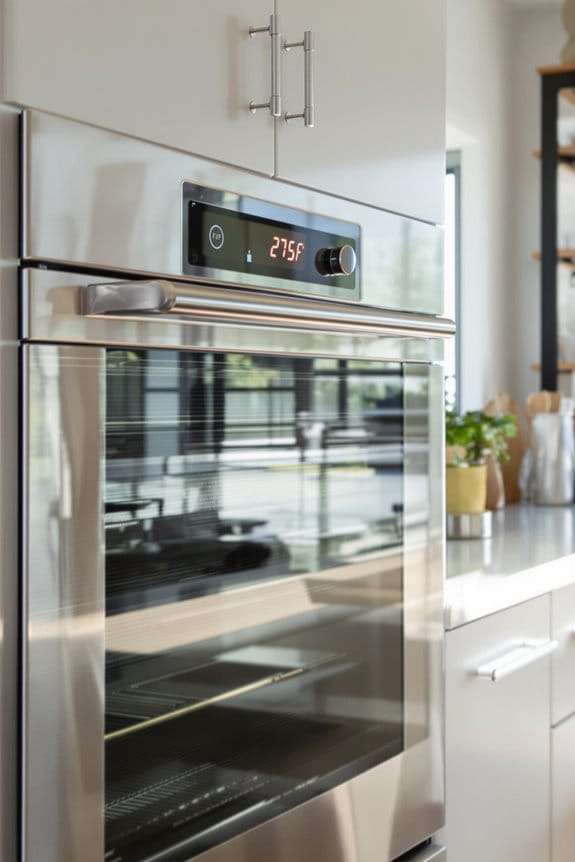
Before you begin gathering your ingredients for the frittata, it’s important to preheat your oven to 375°F. This initial step guarantees that the oven reaches the perfect temperature to cook your frittata evenly.
It’s significant not to skip this because an accurately heated oven is essential for achieving the right texture and flavor. While 375°F is ideal for frittatas, this temperature also plays a key role in gently roasting vegetables until they’re just right, bringing out their natural sweetness and flavor, which is crucial for your dish.
When you set your oven, remember to check that the racks are positioned properly. Often, the middle rack is best for frittatas, offering even heat distribution without being too close to the heating elements at the top or bottom.
Also, take a moment to verify that your oven is clean and free of any lingering smells from previous cooking. This helps prevent unwanted flavors from seeping into your frittata.
New Recipe
- Pepperoni and Hot Honey PizzaTry the tantalizing twist of pepperoni pizza with hot honey, where sweet meets heat—how will it transform your taste buds?
Step 2. Chop Carrots and Zucchini
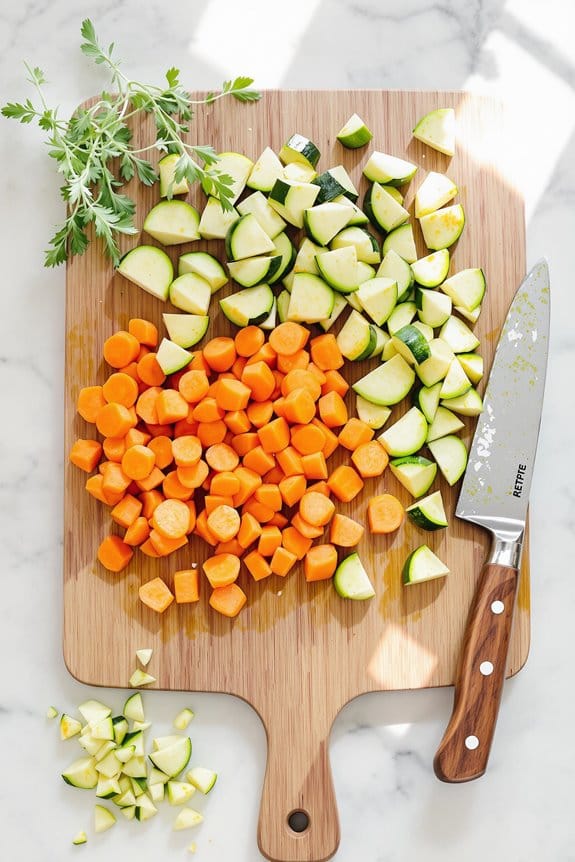
Begin by washing your carrots and zucchini under cool water to remove any dirt or debris.
After drying them gently with a clean cloth or paper towel, it’s time to start chopping. You’ll want to cut off the ends of each vegetable first. For the carrots, peel them to guarantee no rough skin ends up in your frittata; zucchini can be left unpeeled for extra texture and nutrients.
Next, slice your carrots and zucchini. Aim for thin, even slices; about a quarter inch thick is perfect. This not only aids in even cooking, but also guarantees each bite of your frittata is delightfully tender. You can make round slices or, for a more rustic look, cut them on the diagonal.
Once you’ve sliced your veggies, check them for uniformity. Uniform slices cook evenly, which is essential in a dish where every ingredient should shine.
If you find any particularly thick or uneven pieces, simply give them a quick trim.
Step 3. Sauté Veggies Lightly
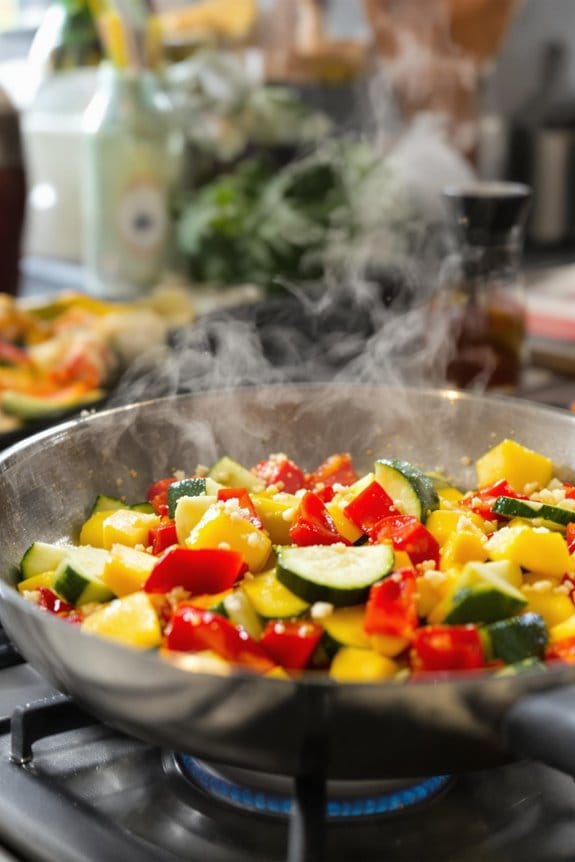
Once you’ve prepared your carrots and zucchini, it’s time to lightly sauté them. Start with a medium-hot skillet and add just the right amount of olive oil. You’re not frying these beauties, just gently coaxing out their flavors and softening them a bit.
Make sure not to crowd the pan – give them space to breathe and get a nice, even cook. Keep the heat moderate. You want to hear that soft sizzle, letting you know they’re getting just the right amount of heat. Toss them occasionally for even cooking, but let them sit enough to get a bit of golden color.
This isn’t just cooking; it’s an art form, delicately balancing heat and movement.
- The sizzle of the veggies as they dance in the pan invites a warmth to the kitchen that feels like home.
- The aroma of sautéing carrots and zucchini blends into a comforting, earthy smell that promises delicious results.
- Watching the colors brighten and deepen pulls you into a moment of culinary creation full of anticipation.
- The texture, slightly tender with a bite, hints at the final, delightful dish.
This careful sauté sets the stage for a frittata that’s as pleasing to the eyes as it’s to the palate.
Step 4. Whisk Eggs With Herbs
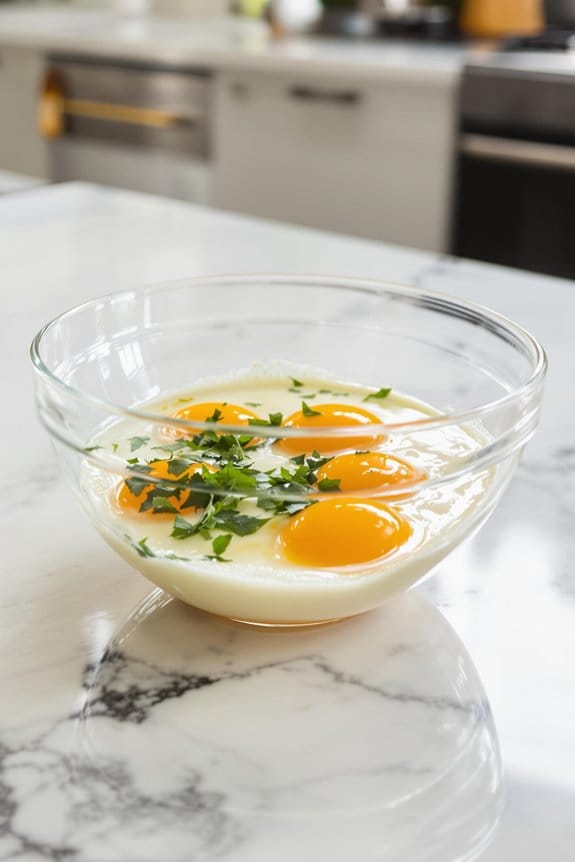
Gently crack the eggs into a large bowl, and whisk them together with freshly chopped herbs to introduce a fragrant depth to your frittata. Choose herbs that complement the roasted veggies—you can’t go wrong with thyme, basil, or chives. These aren’t just flavor enhancers; they’re also packed with antioxidants that benefit your health.
As you blend the eggs with your herb selection, think about consistency. You’re aiming for a light, airy mixture that pours easily but isn’t too runny. It’s the secret to a frittata that’s moist yet firm, elevating it from good to gourmet with just a flick of the wrist.
Don’t forget to season your eggs. A pinch of salt and a grind of black pepper are essential, but don’t be afraid to add a dash of paprika or garlic powder for an extra kick. Each spice not only adds layers of taste but also interacts with the herbs to enhance their natural flavors.
Take this moment to really engage with your ingredients. Whisking isn’t just mixing; it’s about infusing the eggs with air and life, preparing them to encapsulate the flavors of your kitchen’s bounty.
Step 5. Pour Mixture Into Skillet
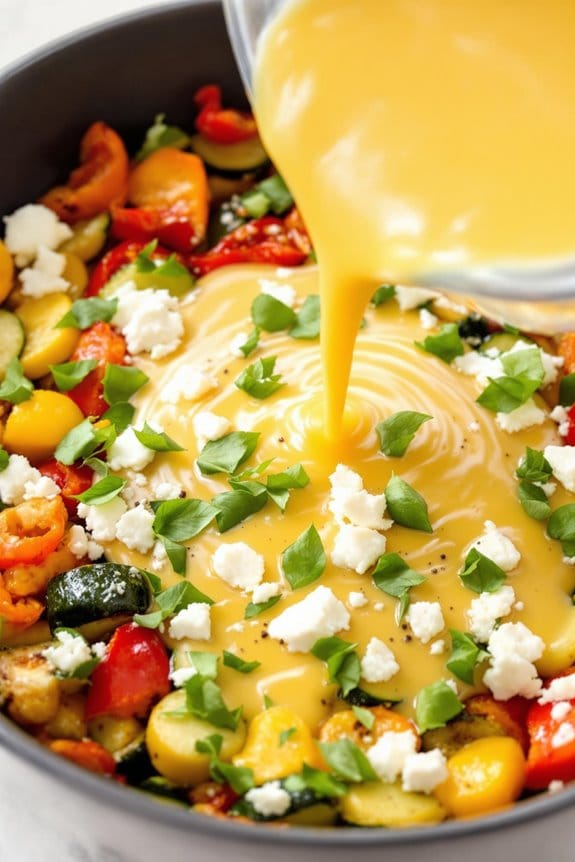
After thoroughly whisking the herb-infused eggs, heat your skillet over medium heat and drizzle in a bit of olive oil to prevent sticking.
Now, it’s time to bring together all the beautiful components of your frittata. Slowly pour the egg mixture into the skillet, letting the golden liquid slide over the sizzling oil. You’ll hear a gentle sizzle—the sound of your creation beginning to take shape.
As the edges start to set, scatter your roasted veggies evenly across the surface. Bits of red bell pepper, zucchini, and caramelized onions add splashes of color like paint on a canvas.
Dot the landscape with crumbles of creamy goat cheese, each piece a promise of tangy delight. Gently stir the mixture with a spatula, ensuring that the vegetables and goat cheese are well-integrated, but also allowing the eggs to reach every corner of the skillet.
*- Imagine the skillet as your canvas, where every ingredient adds a stroke of color and texture.**
** Feel the warmth spreading as the frittata cooks, a cozy embrace extending from your stove.*
*- Relish the sizzles and pops, a symphony of sounds crafting your culinary masterpiece.**
Anticipate the rich aromas** filling your kitchen, heralding the feast to come.*
With love and care stirred into every step, your frittata will soon be ready to delight.
Cooking Tips
Before you begin roasting the veggies for your frittata, make certain each piece is uniformly cut; this guarantees they cook evenly and all parts reach the perfect level of tenderness.
When selecting your vegetables, opt for freshness and firmness; soft spots can indicate past-ripe produce which might result in uneven cooking. You’ll want to toss your veggies lightly in oil before roasting to make sure they don’t stick to the pan and get a nice golden color.
Don’t overcrowd your roasting tray. Space the pieces out so they aren’t touching. This is essential for achieving a caramelized exterior rather than steaming them.
Each vegetable has its own cooking time; start with those that take longer to cook, like potatoes or carrots, then add quicker-cooking items like zucchini or bell peppers halfway through.
Final Thoughts
Crafting a roasted veggie and goat cheese frittata offers a delightful twist to your culinary repertoire. This dish isn’t just a feast for the taste buds; it’s a canvas where the vibrant hues of roasted veggies meet the creamy, tangy goodness of goat cheese.
The satisfaction of slicing into this fluffy, colorful creation is unparalleled. With every bite, you get to savor a harmonious blend of flavors that might just make this your new go-to recipe.
Here’s why this dish stands out:
- Sensory Pleasure: The rich colors and tantalizing aroma promise a true sensory delight.
- Health Benefits: Packed with nutrients from fresh vegetables and protein from eggs, it’s both filling and nutritious.
- Versatility: Perfect for any meal; enjoy it for breakfast, lunch, or a light dinner.
- Memorable Meals: Ideal for gatherings, it leaves a lasting impression on your guests.
Whether you’re looking to spruce up your weekend brunch options or in need of a reliable and impressive dish for your next gathering, this frittata is perfect.
It’s more than just food; it’s an experience that you and your loved ones won’t soon forget.

